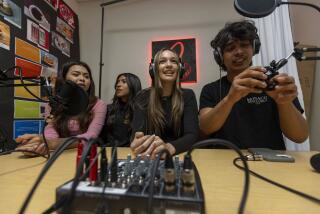CSUN Broadcast Students Face Real-Life Pressure With Weekly Cable News Show
A post-disaster hush fell across the TV studio at Cal State Northridge. The dress rehearsal for “Valley View,” a student-produced news show set to debut Monday on West Valley Cablevision’s Channel 65, had ended in a tangle of botched cues, missing graphics and dead air.
Jerry Jacobs, broadcast journalism instructor, shrugged and recalled the stage axiom.
“A horrible rehearsal means a great opening night,” he said.
Then, unwilling to rely on lucky sayings, he ordered everyone to run through the show again.
Jacobs said that the weekly program will be the only television newscast reporting exclusively on the San Fernando Valley and that “we aim to be as good as what you see on the professional channels, maybe better.” To back up the prediction, he pointed to numerous awards won by CSUN’s broadcast journalism students for documentaries produced over the last four years.
Still, the news program is ambitious for several reasons. Its 10 would-be journalists are encountering deadline pressure for the first time. They are also working for the first time with students in CSUN’s Radio, Television, Film Department, who serve as the show’s technicians.
Most of “Valley View” will be put together on Monday, the air day, and the 4:30 p.m. taping time will not leave much leeway for whipping stories into shape. The finished tape must be delivered to the cable company in time for airing at 7 p.m.
This week’s rehearsal led off with police and court stories, followed by a report on a male professor at CSUN accused of exposing himself to two female instructors. In something of a coup, the student reporter, Tamara Iwerks, taped an interview with one of the two women. The piece was followed by in-studio questioning of a member of a faculty committee that investigates sexual harassment complaints on campus.
Christopher Heinbaugh, the student who will produce the first three or four newscasts, said the show is not designed to focus extensively on CSUN.
“The campus is going to be just one of our beats,” he said. “Local stations like KCBS or KTTV might have one or two stories a night about the Valley. We’ll be all Valley.”
The rehearsal continued with pieces on voluntary graffiti-eradication efforts, the family of a Valley athlete in the Seoul Olympics, CSUN’s deaf studies center and the role of Valley companies in the space shuttle launch. A section called “Week in Review” looked at stories from the previous week. The show ended with a feature on Frisbee golf.
The class plans to cover the area served by West Valley Cablevision, which is wired into 70,000 Valley homes west of the San Diego Freeway. The company is airing the show as part of its public access programming.
“We want to cover our own back yard,” instructor Jacobs said. “It’s something that’s done less and less in television news.”
Using a grant from the Gannett Foundation, Jacobs conducted a six-month tour this year of television stations in the United States, Japan and five European nations. He said the boom in satellite news transmission has lured many local stations into reporting national and international stories at the expense of local coverage.
“Look at KNBC,” he said. “They’re originating a local newscast from Seoul. That makes no sense at all.”
Students receive three units of credit for producing “Valley View.” All have taken classes in print journalism and produced news for KCSN-FM, the campus radio station. Most are seniors, but a few have graduated and are taking the class for its training value.
“I came back because this is the best preparation you can get for live, on-air covering of real stories,” said Kathy Anderson, who is assignment editor for the first few shows.
Plans call for students to rotate in the jobs, assuming new tasks throughout the semester. Anchors for the first shows will be Randy Thomasson and Wendy Randall. At the rehearsal, Thomasson sat on his coattail to keep his collar from riding up, like William Hurt in “Broadcast News.” In another anchor’s tradition, Randall dressed for the camera from the waist up only, knowing that her shorts and beat-up tennis shoes would be hidden behind her desk.
Class members know how to operate an array of equipment and are facile in the use of such TV news jargon as B-roll (the scene-setting tape that accompanies a voice-over) and C.G.s (the names produced by a character generator and superimposed on the screen).
Monday they will have a chance to handle a tougher test--producing an actual show on deadline.
More to Read
Sign up for Essential California
The most important California stories and recommendations in your inbox every morning.
You may occasionally receive promotional content from the Los Angeles Times.










